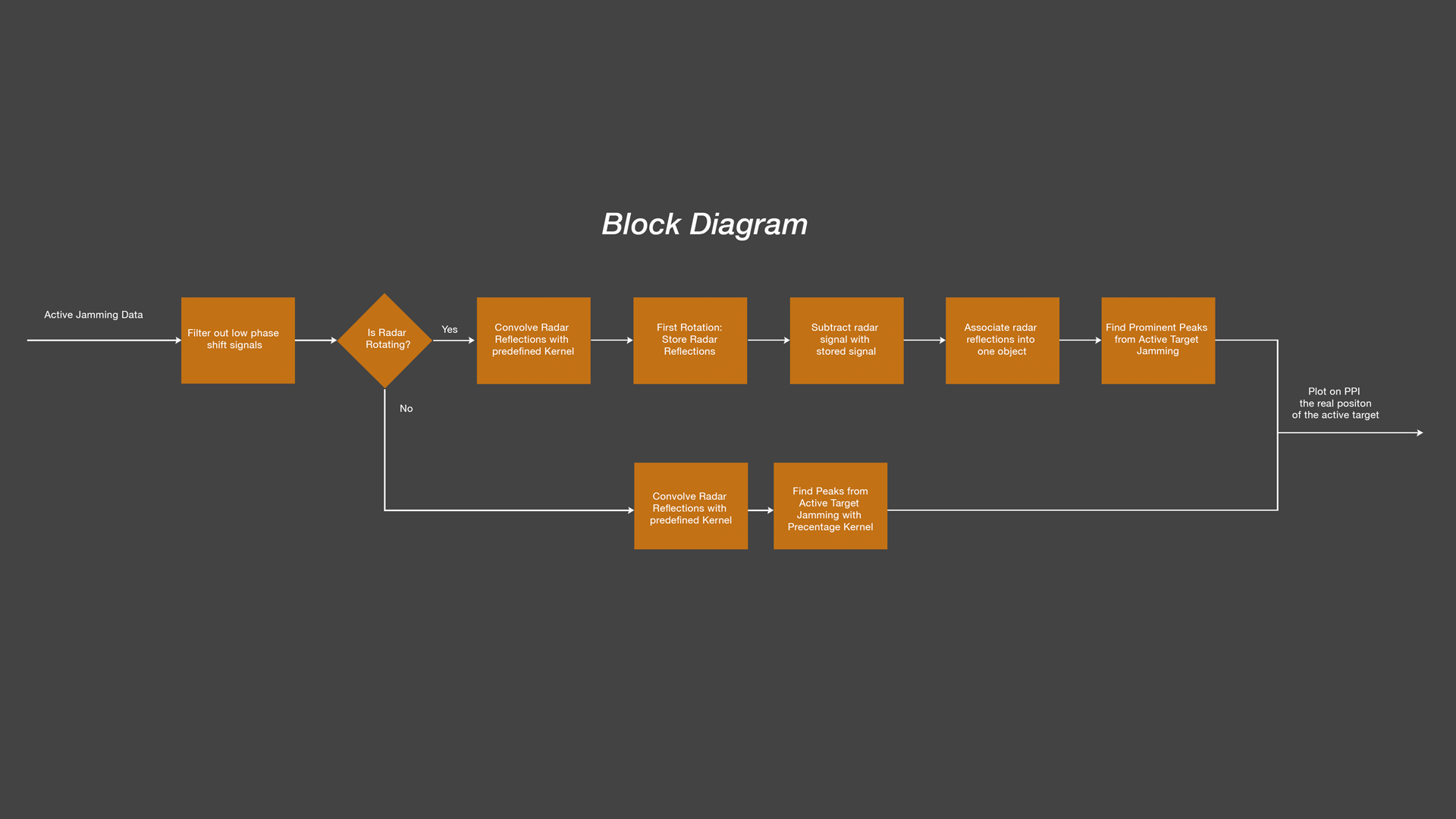The Doppler Phase Shift Enhanced Disturbance Filter (EDF) is an advanced radar signal processing system designed to effectively handle jammed radar data. It utilizes sophisticated algorithms to distinguish genuine radar reflections from jamming signals, thereby enhancing the radar's ability to accurately detect and track targets even in hostile environments.
2 Videos with Live Data and with Simulated Data
The following two videos show how jamming can be deteced using Doppler Phase Shift Detection together with a set of additional filters. Below we share two videos. The first video is a recording of a real jamming, using a physical active target (Read this blog with more details on the jammer). You see that the physical target is closer to the radar source than the actual fake target, created by the active target. Eventually, the detection filter, introduced in this article labels the real physical target with a plot.
Video - Real radar with active target detection
We made the second video with simulator data. In this case, a DRFM jammer creates a fake target which is closer to the radar source than the real physical target. The algorithm is able to detect the real physical target and to label it with a plot.
Video - Simulator with active target detection
In the text below we explain the algorithm. SkyRadar provides this detection algorithm, physical active targets and simulation environments in the frame of its training suites for civil and military training.
Subfunctions
1. Filter out Low Phase Shift Signals
Description: This sub-feature identifies radar signals with low phase shifts, indicating weak or irrelevant reflections.
Function: Eliminates noise and clutter to improve signal-to-noise ratio.
Use: Enhances radar performance by focusing on meaningful reflections while reducing interference from irrelevant signals.
2. Check if the Radar is Rotating
Description: Determines the motion state of the radar platform.
Function: Provides crucial information for subsequent processing steps.
Use: Allows for the application of appropriate algorithms based on the radar's motion characteristics, optimizing signal processing efficiency.
3. Convolution
Description: Enhances radar reflections through convolution with a predefined kernel derived from reference data.
Function: Improves signal quality and feature extraction.
Use: Prepares radar data for further analysis by enhancing relevant signal characteristics.
Explainer:
Not everybody might be familiar with the terms convolution and kernel. Here comes a short explanation:
Convolution is a mathematical operation used in signal processing where two signals are combined. In the context of radar, convolution is used to modify and enhance the signal received after it is reflected from an object.
A kernel in this context is a set pattern or matrix of numbers that is used in the convolution process. This kernel is predefined, meaning it is set based on prior knowledge or specific design criteria to achieve the desired effect on the radar signals. The predefined kernel is created using reference data, which consists of previous measurements or theoretically ideal responses. This data helps to shape the kernel so that it can effectively enhance the radar reflections by highlighting or suppressing certain features in the signal.
4. Store Radar Reflections
Description: Records radar reflections during the initial rotation cycle.
Function: Establishes a baseline for comparison with subsequent rotations.
Use: Facilitates the identification of anomalous signals by comparing them to stored baseline data.
5. Subtraction
Description: Isolates new or changing radar reflections by subtracting the current signal from the stored baseline.
Function: Highlights deviations from baseline reflections.
Use: Enables the detection of anomalous signals, potentially indicative of jamming interference.
6. Target Association
Description: Groups related radar reflections into coherent objects or tracks.
Function: Facilitates target identification and tracking amidst jamming interference.
Use: Improves situational awareness by organizing radar data into meaningful objects or tracks.
7. Find Prominent Peaks from Active Target Jamming Device
Description: This sub-feature identifies significant peaks in radar data, particularly those caused by active jamming devices. Prominent peaks are discernible features that stand out distinctly from the surrounding baseline or noise level of the signal.
Function: It calculates the prominence of each peak in the radar signal, measuring how much a peak stands out from its surroundings. The prominence is determined by the vertical distance between the peak and its lowest contour line, providing a quantitative measure of peak significance.
Use: By identifying prominent peaks, the system can effectively distinguish genuine radar targets from jamming interference. Peaks with higher prominence values are indicative of stronger and more pronounced features in the radar data, making them more likely to represent genuine targets or jamming signals. This sub-feature aids in enhancing radar situational awareness by highlighting significant radar returns amidst noise and interference, thereby improving target detection and tracking capabilities.
8. Find Peaks from Active Target Jamming with Percentage Kernel
Description: Identifies peaks in radar data using percentage kernel window functions.
Function: Enhances sensitivity to jamming signals by focusing on localized signal variations.
Use: Enables the detection of active target jamming based on significant signal increases within localized areas.
Conclusion
The integration of the Doppler Phase Shift EDF's new feature set represents a significant advancement in radar signal processing capabilities, particularly in handling jammed radar data. By incorporating sub-features such as filtering out low phase shift signals, determining radar motion state, and employing sophisticated algorithms for both rotating and static scenarios, the EDF enhances its ability to discern genuine radar reflections from jamming interference.
Moreover, the introduction of the "Find Prominent Peaks from Active Target Jamming Device" sub-feature adds a critical layer of functionality by calculating the prominence of peaks in radar data. This enables the system to identify significant features that stand out from the surrounding baseline, thereby improving the detection and characterization of active jamming devices.
Together, these enhancements empower the Doppler Phase Shift EDF to operate effectively in hostile environments, ensuring reliable target detection and tracking capabilities even in the presence of jamming devices. By providing a comprehensive solution to mitigate the impact of jamming, the new feature set reinforces the EDF's position as a vital component in modern radar systems, enhancing overall operational effectiveness and mission success.
Many Applications for Electronic Warfare
Follow our blogs and videos on Electronic Warfare with SkyRadar's Disturbance Filtering & Analysis solutions, the jammers and the Pulse Radar! SkyRadar is the only provider world-wide, providing manufacturer-agnostic ECM and ECCM training with simulators and real radars and jammers. Learn more about the simulator, range deception, angle deception, speed deception, radar lock on and major state of the art defense algorithms against malicious attacks.
Such defense is not only useful in a military context but also in a civil aviation setting. Increasingly speed radar jammers by trucks and cars disturb airport infrastructure. Also hybrid warfare is used to perturb critical infrastructure like airports and civil air surveillance and navigation services.
Please note that all delivery is subject to the EU export regulations. Also this blog publication and video do not share classified information.





